The bloody finale of the Budapest group
After February 10 1945, the German command in Budapest had no choice. It was necessary to break through or surrender, as the integral defense collapsed. The Germans were not going to give up, so it was decided to break through. General Pfeffer-Wildenbruch reported to the headquarters of Army Group South, that all food supplies were exhausted, ammunition would soon run out, therefore, choosing between surrender and breakthrough, the last combat-ready German-Hungarian units would launch an offensive operation. The start of the offensive was scheduled for February 20 watches 11.
After long discussions, the Military Council decided to make a breakthrough in small groups in a wooded area, avoiding major roads and almost abandoning heavy weapons. Actually, their use was practically impossible, since there was no fuel for armored vehicles, and the narrow streets of the city were littered with various debris, as well as covered with barricades, special rubble and other obstacles. In addition, the movement of armored vehicles could not be hidden, which deprived the attackers of the main trump card - surprise. Several battle groups were given the task of breaking through the Soviet defense line in a section about 1 km wide, which stretched from Sella Kalman Square, through Sennaya Square, Margarita Avenue and ended at the Margarita Bridge. German-Hungarian troops were supposed to flood into the resulting outburst. In the first echelon were the remains of the 13th tank of the division and units of the 8th SS Cavalry Division, in the second - the Feldherrnhalle Panzer Division and the 22nd SS Cavalry Division, followed by lightly wounded soldiers who could move on their own, in the rear there was a convoy with seriously wounded and civilians who did not want to give up. The attack of the first wave was supported by a number of tanks and armored vehicles. The attackers did not go on a solid front, but were divided into groups led by Hungarians who knew the area well.
The task was almost impossible. The remnants of the German-Hungarian units, weakened and experiencing a shortage of ammunition, had to penetrate or break through the first line of the Soviet defense, gather on Mount Remet, that is, in the 21 kilometer from the place where the operation started, to strike again in a westerly direction. The next assembly point was in the forest to the east of Tinnier. From there it was necessary to break through the outer ring of the environment from the rear and go out to our own. The entire operation was given 18 hours! At the same time, there was a faint hope that the troops of Army Group South would launch a counter movement and support a breakthrough, help break through even the outer ring of the encirclement. The plan of operation was kept in the strictest confidence. Division commanders found out about him only in 14 hours, regimental commanders in 16 hours, and battalion commanders in 18 hours, that is, two hours before the start of the breakthrough. Hungarians were not trusted and informed only in 18 hours. Only the commander of the 1 of the Hungarian corps, Ivan Hindi, was dedicated to the 16 hours. For the purpose of secrecy, the destruction of the remaining equipment and supplies that could not be taken with them, began just before the start of the operation.
True, it was not possible to completely conceal the preparation of the operation from the soldiers. Rumors about the upcoming breakthrough began to circulate in the evening on February 10, but this was extremely vague information, without any details. The soldiers and officers understood that everything was gone. An indirect sign of defeat was the massive rewarding of Knight's crosses and other awards in the period from 6 to 10 in February (they also "cheered" the perishing troops in Stalingrad). Officers received unexpected promotions. Among the soldiers and officers there were the most ridiculous rumors. Many hoped that it would be necessary to go only a few kilometers and they would be met by troops of Army Group “South” moving towards them, which was on the way of only “a few Russian patrols” or weak Romanian units. As they say - a drowning man grabs a straw.
Pfeffer-Wildenbruch did not suffer illusions. He understood that a breakthrough was doomed to failure; there would be no outside help. Therefore, he and the SS Oberführer Helmut Dörner formed a selective group of 500 SS men who had to break through in the most convenient place - through the Devil's ditch. Here, according to the Germans, Soviet troops controlled only certain sectors. And the Pfeffer-Wildenbruch and Dörner group could have avoided the first, most difficult and cruel fight. In essence, the commander of the Budapest grouping was abandoning the rest of the troops to the mercy of fate.
It is clear that the Soviet command guessed the plans of the enemy. It was obvious that the Germans would try to break through the shortest path that went through the forest, where they could escape and avoid the effects of Soviet armored vehicles. Found and some signs of a future offensive. Therefore, on the way of a possible breakthrough of the enemy troops, three defensive lines were prepared. At the same time, it was provided that the first line of defense along Margarita Avenue could fall. The troops who defended the first frontier had to retreat along a special route and lure the enemy into a fire bag. The 180-Infantry Division stood in the way of the German troops, which was significantly inferior to the enemy group in numbers.
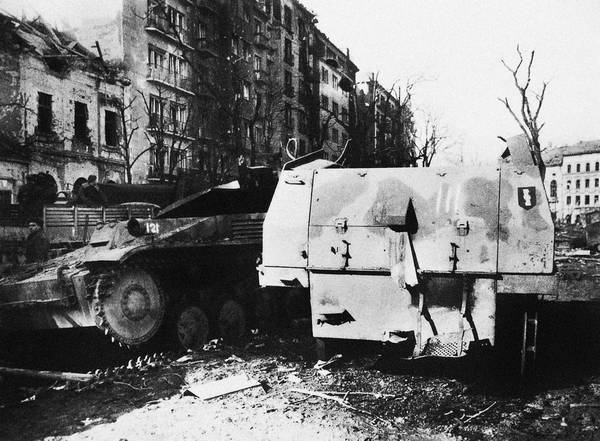
105-mm light-duty self-propelled howitzer “Wespe” (left) and 150-mm heavy self-propelled howitzer “Hummel” (right) destroyed during the fighting in Budapest
division "Feldkhernhalle." February 1945 of the year
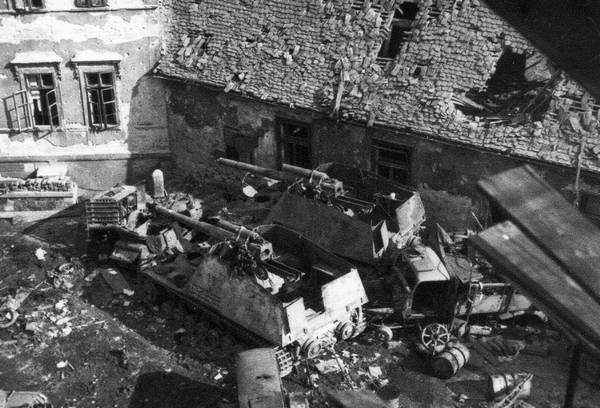
Two 150-mm heavy self-propelled howitzers "Hummel", abandoned in the yard of a house in the suburbs of Budapest. February 1945 of the year
Breakthrough
February 11 in 20 hours the first shock groups went on a breakthrough. Captain Helmut Friedrich wrote about this watch: “There was some sort of anxiety in the air. Heard jerky commands. The roofs of the houses were lit by signal flares. After the rockets were extinguished, impenetrable darkness again set in in the alleys. From all sides the soldiers rushed only to the north. ... comrades are dying. On the narrow streets of the crowded hustle. In the pitch darkness, everyone is moving forward literally to the touch. ... For the commanders of the combined-arms units, this was a depressing attempt to escape, an animal rush to save his life, an act of despair. At that time, the soldiers obeyed only the instinct of self-preservation. Nobody paid attention to what was going on aside. ... Everybody roars "forward"! Right and left, people are also obsessed with wanting to break through the ring of the environment as soon as possible. They behave like cattle, jostle themselves with elbows, walk over corpses, kick the wounded. "
Organized attack failed. Even before the attack of the first echelon, crowds of soldiers began to gather on the streets, they were mixed up. The front ranks of the attackers were literally mown by machine-gun, mortar and artillery fire. The first echelon was knocked out almost completely around the post office and Varoshmayor. As the survivors recalled, they had to make their way through the "mountains of corpses." Streets and squares were littered with bodies. Among those killed was the commander of the 13 Panzer Division Gerhard Schmidhuber. The commander of the SS 22 Cavalry Division, Augustus Zeeender, lost his arm during the attack and preferred to shoot himself. The commander of the SS 8 Cavalry Division, SS Brigadefuhrer SS Joachim Rumor and officers close to him also preferred to commit suicide. Many seriously wounded asked to finish them off in order not to suffer or end their lives by suicide.
The first attacks of shock groups choked in blood. But in some areas the Germans and Hungarians were still able to advance. At the cost of incredible losses, the remnants of the first echelon broke through the positions of the 180 Infantry Division. In some places, the Soviet soldiers, amazed by the huge number of enemy soldiers trying to break through and their animal fanaticism, when the Germans and Hungarians, despite their enormous losses, tried to move forward, retreated. However, advancing on 2-2,5 km, the Germans and the Hungarians faced a second line of defense. At the same time, human bodies literally covered the streets and squares. The second-tier soldiers from such a spectacle were shocked and often simply refused to go forward. Chaos and panic intensified. The offensive stalled for several hours.
The organization of the attack has plummeted. New attacks were prepared worse and led to unnecessary losses. The occupied territories were not “cleaned up”, they were left behind by separate groups of Soviet soldiers who occupied the upper floors and continued to resist, harming the enemy. The third wave, in which they were lightly wounded, basically chose to go home and basement, to hide, then to surrender to captivity. The soldiers were scared and did not want to die.
By midnight, the second echelon, suffering heavy losses, was able to advance several hundred meters. Most of the leadership died, the troops were completely disorganized. Separate groups still tried to break through and suffered heavy losses, died. Part of the retreating lost, was blocked. But some groups were able to break through the Soviet line of defense. This was how the Feldhirrnhalle division group managed to break through under the command of Lieutenant Colonel Helmut Wolf, who actually led the remnants of the division from January (the commander of the Feldhirrnhalle motorized division at the last moment left Budapest and was able to avoid the environment). At dusk, the soldiers of the Wolf reached the great summit of the Swabian Mountains, where they joined with another large group of retreating troops. As a result, the strength of the Wolf battle group was 3200 soldiers. Another large group was led by the commander of the 66-go motorized regiment Schöning. As a result, under the cover of thick fog to the Buda Hills, about 16 thousand people managed to break through.
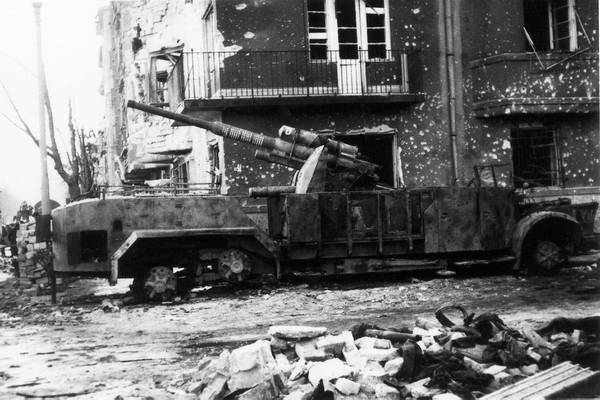
88-mm self-propelled Flak 36 anti-aircraft cannon on the chassis of a BUSSING-NAG three-axle vehicle, shot down outside in the suburbs of Budapest. February 1945 of the year. Rings are visible on the gun barrel - the number of enemy aircraft shot down
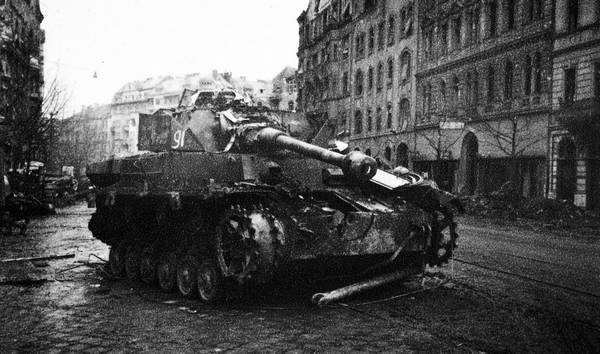
German tank Pz.IV Ausf.H, padded and left on the street of Budapest
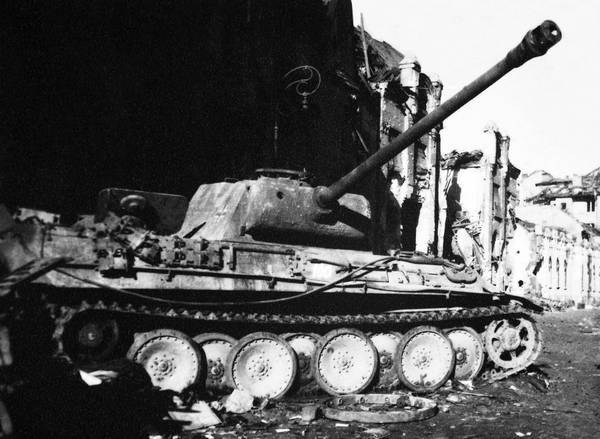
German tank Pz.V Ausf.G "Panther", left by the crew during the battles in Budapest. February 1945 of the year
Pfeffer-Wildenbruch Group Actions
The Pfeffer-Wildenbruch group broke through a separate route. The group included the headquarters of the German and Hungarian corps, the shock group of SS Dörner, as well as part of the anti-aircraft gunners and pilots. The Germans were planning to bypass the Devil's ditch and go to 2 km behind the line of Soviet defense. The entrance to the underground passage was near the so-called “big castle tunnel” in 2 km in front of the Soviet positions. That is, the total way underground was supposed to be about 4 km.
The underground march began at 23 hours. The first to move were well-armed SS men, who were to clear the way and, if necessary, pave the way. The soldiers dragged on themselves faustprony, machine guns, mortars, etc. weapon, ammunition. It was extremely difficult and inconvenient to move along the canal: the width of this structure was about 1 m, and the pipe diameter was about 3 m. In addition, the idea of using the canal for salvation came to mind not only the headquarters, several independent groups were found in the building. The water level has risen due to the large number of people and it has become harder and harder to get through. Many could not go all the way through the Devil's ditch and left the pipe. So he went upstairs and was joined to one of the bursting out groups by the Chief of Staff of the SS 9 Mountain Corps of the SS Colonel Uzda Lindenau. He was almost immediately captured.
By morning, the advance team had come out of the ditch. But the SS Dorner faced strong resistance and could not get through. Dörner himself died. Pfeffer-Wildenbruch also rose to the surface and was captured. Other German small groups that were able to slip out of the ditch were soon discovered and blocked by February noon 12. Someone gave up, part of the SS, fearing for their future, committed suicide. The Hungarians, seeing that all the attempts of the Germans to break through failed, eventually came back. Their attempts to emerge anywhere in the city and get lost in the neighborhoods did not lead to success. At the exit, the headquarters of the Hungarian 1 Army Corps, led by General Ivan Hindi, was captured. As a result, the most “safe” path became a failure.
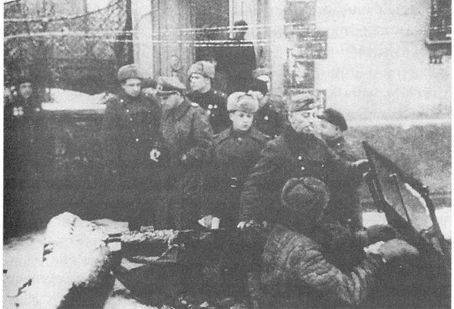
Pfeffer-Wildenbruch and Lindenau arrested by the Red Army
The end of the Budapest group
By the morning of February 12, a breakthrough in the defense of the 180-th division arrow was closed and the Soviet troops began clearing Budapest. A large role in this operation was played by Hungarian volunteers who went over to the side of the Soviet troops. It was the Hungarian volunteers who occupied the building of the royal palace.
It is worth noting that in the territory adjacent to the Buda Castle, there is a fairly large number of troops and wounded. Some units received orders to start retreat too late or did not receive them at all, others remained on purpose to surrender, believing that the breakthrough was a hopeless enterprise. They practically did not resist, and before delivery they smashed the warehouses with the remnants of stocks.
Especially difficult situation was with seriously wounded. Most of the medical staff ran. The wounded, who were placed in improvised hospitals, were in a panic in the basements, believing that they would be shot. Some committed suicide. There were no more procedures, bandaging and the treatment itself, the wounded lay in their stools. As Ensign Aladr Konkoy-Tege (a doctor before the war) wrote: “The room was lit with only a few candles and lamps. The air was stale before choking. It smelled of pus, blood, sweat, urine, cigarette spirits and dirt in one stench. The stench was terrible. He interrupted any odors, even spread through the corridors. The light of pocket lanterns tore horrible pictures from the darkness. On both sides of the tunnel, wounded lay in long rows on wooden platforms. Many had to be content with bare concrete. ... Almost all bloody festering wounds. Someone had open fractures. ... The wounded could hardly move. They lay in their own secretions, weakened and helpless. ... Everywhere there were groans, lamentations, prayers, scraps of German curses. ... The floors of the hospital were very reminiscent of the circles of hell described by an Italian poet. Paralyzed, blind, and those who survived after putting a bullet in the forehead were located on the lower floor ... Those who were here received a little bit of anesthetic. ” In a military hospital, fires caused by smoking wounded people repeatedly flashed. The wounded burned alive, as they put out fires, and there was no one to carry people out. One such big fire, according to various sources, led to the death from 300 to 800 people.
By the end of the day, the city was cleared of the remnants of the German-Hungarian troops. More than 20 thousand people were captured. From February 14, the main forces of the Soviet Budapest Group of Forces were aimed at pursuing the enemy. Finally, the city was cleared by February 17.
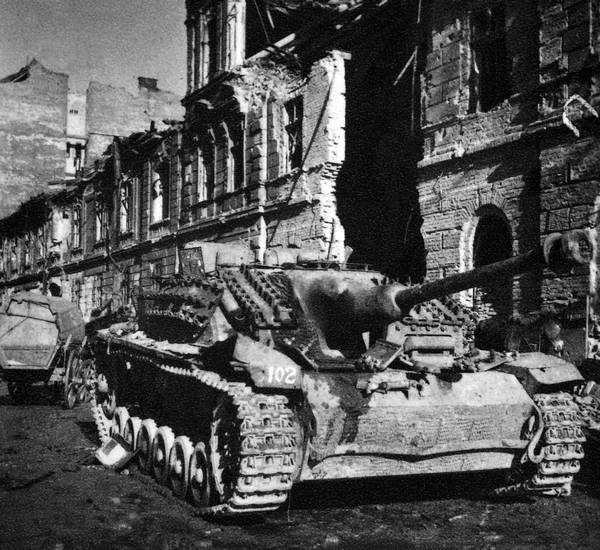
StuG 40 assault gun left by the crew on Budapest Street. February 1945 of the year. The machine is covered with zimeritom, spare tracks are attached to the deck for additional protection.
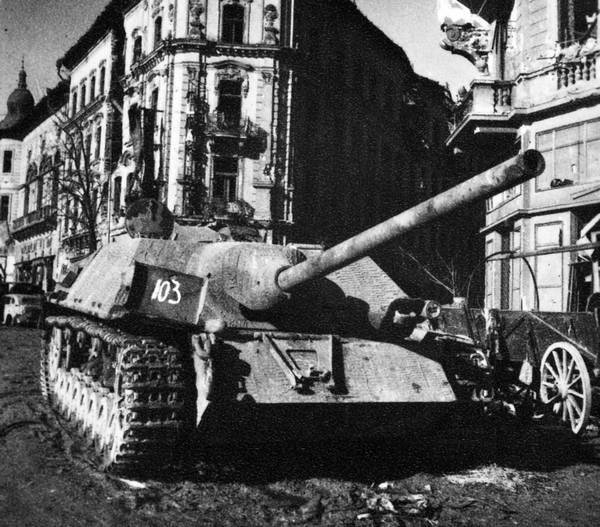
Tank destroyer Pz.IV / 70 (V), left by the crew due to a breakdown in the absence of fuel. Budapest
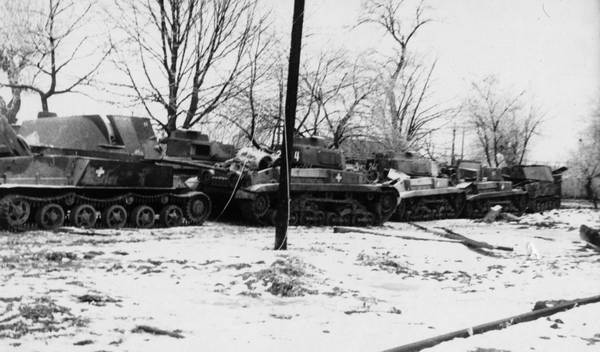
Hungarian armored vehicles abandoned in Budapest: 40-mm anti-aircraft self-propelled guns 40M "Nimrod" and tanks "Turan". February 1945 of the year
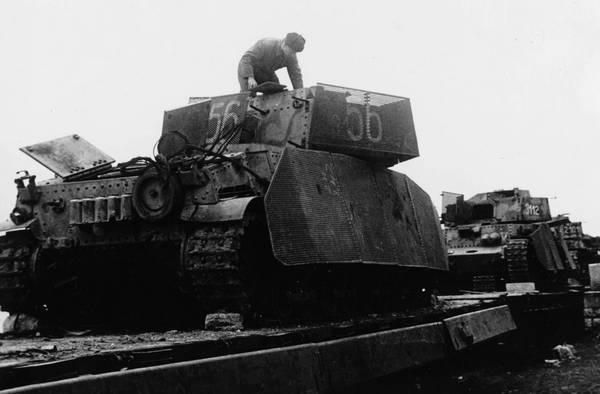
A Soviet soldier inspects tanks “Turan” II abandoned on railway platforms with turret and side screens. Suburb of Budapest
On the ways of a possible withdrawal of the enemy, barriers were set, ambushes, and horse patrols were combing the terrain. Several large groups of German-Hungarian troops were destroyed by units of the 46 Army. The 2 Guards Mechanized Corps and the 5 Guards Cavalry Corps were turned against the remnants of the Budapest enemy grouping. Disorganized, completely lost morale, abandoned part of the weapons and hungry soldiers could not provide serious resistance. Many threw weapons and surrendered. Recent attempts to break through led to new slaughterhouses. In these battles, some troops, consisting of several thousand fighters, were literally exterminated. From the whole detachments to their punched units and dozens of soldiers. By February 15 most of the Germans and Hungarians who had broken through from Budapest were destroyed or captured. Only about 700-800 people came out to their own. Many were injured. The largest groups led Col. Helmut Wolf, the commander of the Feldherrnhalle, and the commander of the 66 th motorized regiment of the 13 Panzer Division, Wilhelm Schöning. In total, during the 4-day cruel battle, the German group lost about 40% of their numbers killed, the rest were captured. Less than a thousand people broke through to their own.
The command of Army Group South and the Army Group Balka helplessly watched the end of the Budapest group. They did not have time to organize a new counter-attack, no forces and equipment to make it successful. 17 February, the Soviet Budapest group was disbanded. The operation was successfully completed. The breakthrough of the Budapest grouping did not come as a surprise to the Soviet command and led to the complete destruction of the German-Hungarian garrison of Budapest.
The liquidation of the Budapest garrison was one of the favorable prerequisites for an offensive against Austria. Of the European capitals taken by the Red Army, Budapest ranked first in the length of street fighting. During this battle, the enemy, according to various sources, lost from 100 to 188 thousand people.
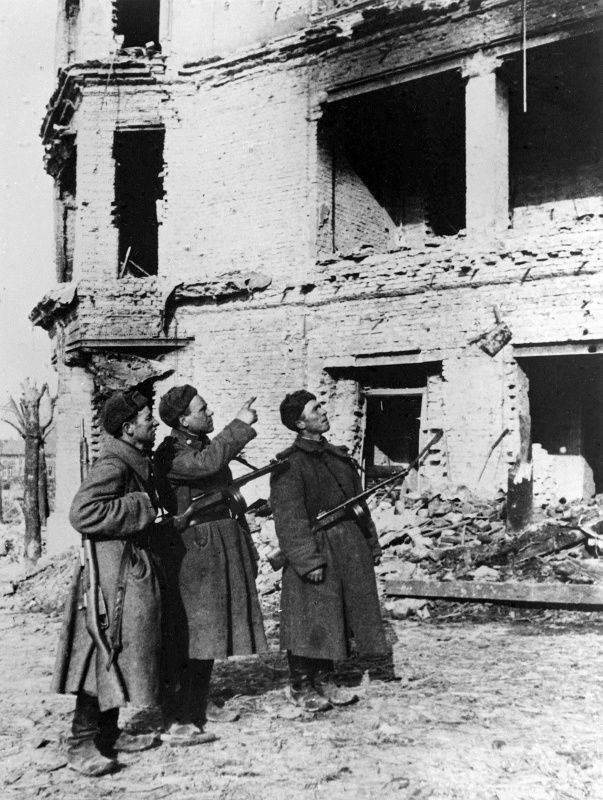
Soviet soldiers view the battle-damaged house of Budapest
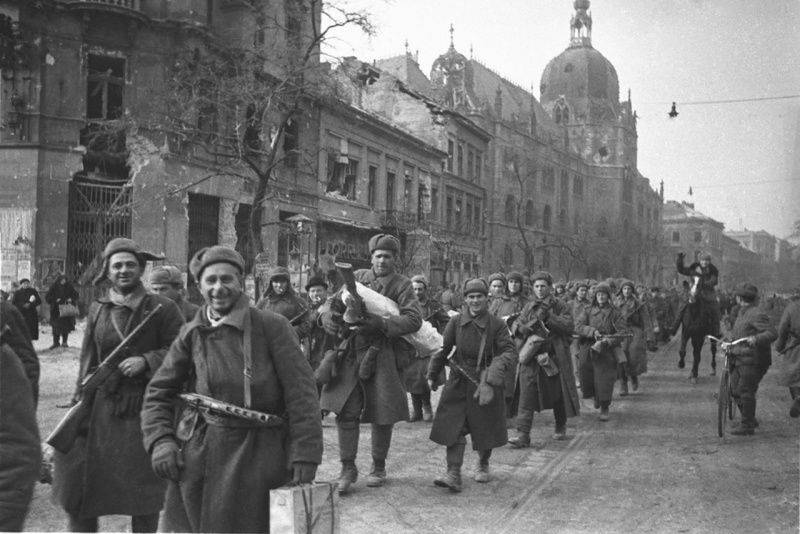
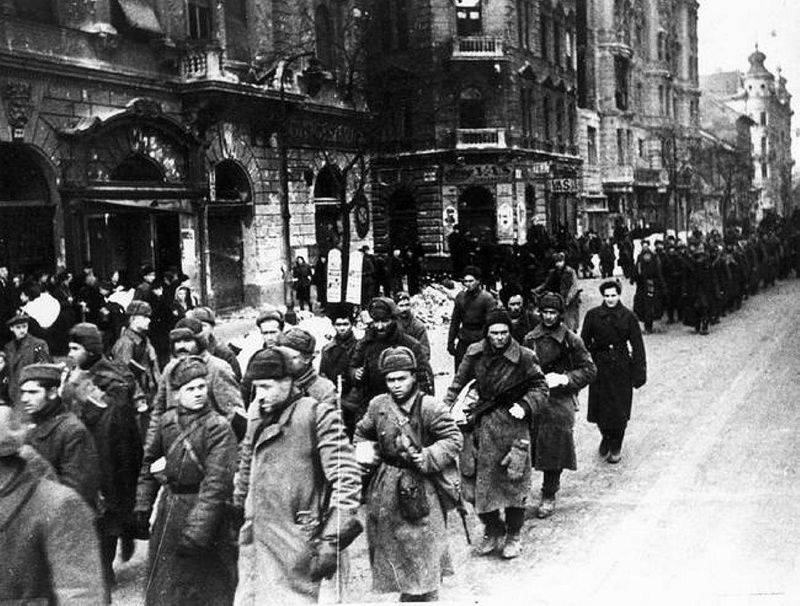
Column of Soviet soldiers on the street of Budapest
Sources:
Vasilchenko A.V. 100 days in bloody hell. Budapest - “Danube Stalingrad”. M., 2008.
Isaev A.V., Kolomiets M.V. Hitler’s latest counterstrikes. Defeat Pantservaffe. M., 2010.
History Great Patriotic War of the Soviet Union 1941-1945 In 6 M.T., 1960-1965 // http://militera.lib.ru/h/6/index.html.
Liberation of Southeast and Central Europe. The liberation of Hungary // http://www.warmech.ru/easteur_0/hun00.html.
Portuguese R., Runov V. "Boilers" of 45. M., 2010
Frisner G. Lost battles. M., 1966 // http://militera.lib.ru/memo/german/friessner/index.html
http://waralbum.ru/.
- Alexander Samsonov
- Part 1. Storm and Budapest capture
Part 2. Breakthrough "Attila Line". The beginning of the Pest assault
Part 3. Fall Pest. The beginning of the storming of Buda
Part 4. Strong assault on Buda
Part 5. Operation "Conrad"
Part 6. The bloody finale of the Budapest group
Information